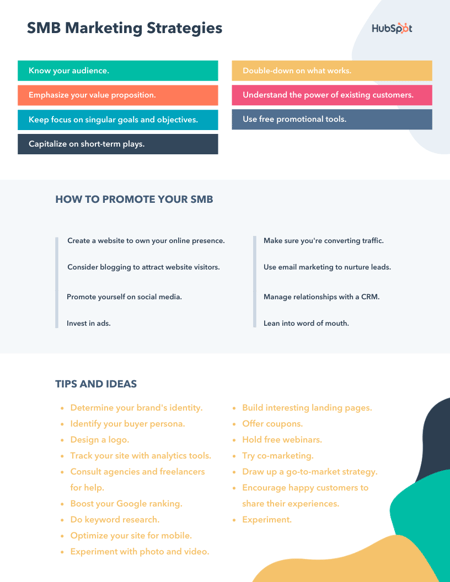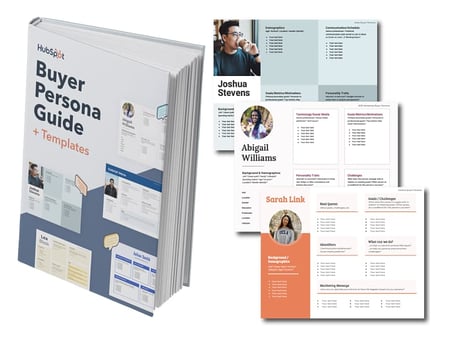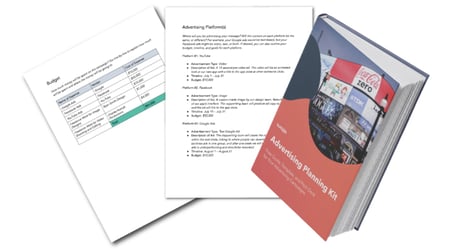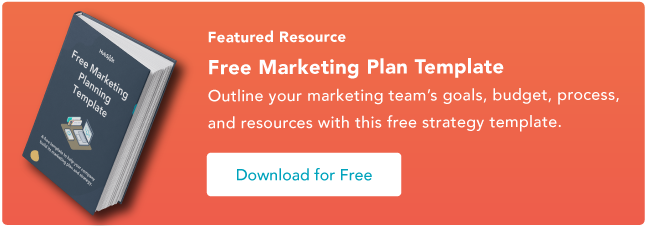46 Ideas for Your 2022 Small Business Marketing Strategy
Whether you're in the process of launching a new business or already have one, having a strong online presence for your brand is extremely important.

Whether you're in the process of launching a new business or already have one, having a strong online presence for your brand is extremely important. In fact, consumers learn about local businesses online more than anywhere else, with Statista predicting the number of ecommerce users to grow to nearly 274 million by 2025. If you're a small business owner with little experience in online marketing, creating a strategy to boost your online presence may feel overwhelming. Have no fear — we've got you covered. In this post, we'll help you build and optimize your small business marketing strategy using inbound marketing, setting you up to attract new clients and ultimately grow your business. Marketing is meant to raise brand awareness and build a pipeline of qualified leads that turn into sales. With a small business, getting the word out can be challenging due to less visibility and lack of resources (like budget or time). However, there are key strategies that can help you scale your small business's marketing efforts. Whether you're struggling with a limited budget, the time restraints caused by having a smaller team, or even a lack of direction, a marketing plan that's appropriate for your business can provide guidance as you scale. These strategies are fundamental as you generate awareness and revenue for your organization: A key mistake is thinking that "anyone" is your buyer. Larger companies may be able to appeal to a wide market, but they say, "the riches are in the niches" for a reason. A niche is where you'll have the most leverage as a small business. And to develop a niche and appeal to buyers within the niche, you must understand their pains, problems, triggering events, and priorities. What is pushing them to make a purchasing decision? What does it look like if they succeed? Knowing these things will help you craft messaging that resonates and makes a compelling case for your solution. Start by thinking about your existing customers and who you'd like to work with. Then, create a buyer persona to start the process of getting into the head of your ideal client. Download Free Buyer Persona Templates If there's no difference between you and your competition, there's no reason why a buyer would be compelled to work with you. Your value proposition is what will differentiate you from others in your space and make up your prospects' minds that you're the provider to go with. What do you do better than anyone in the industry? Conveying this makes a compelling argument. If you're exploring the world of marketing, you may have noticed that there are a gazillion directions you can go in. It's tempting to do it all at once and craft a complicated machine in hopes that you covered all your bases, and it's easy to take on too much. Instead, identify where the biggest impact will be. Where is the biggest blind spot in your marketing that's prohibiting your growth? Set a performance goal around that one key area and focus your resources on the activities and tactics that will achieve that one performance goal. You can expand your efforts or pivot to other initiatives when you've made more progress toward that singular goal. Start scrappy. As you scale, it's critical to see ROI sooner. This will give you the momentum and cash flow to put toward larger projects, long-term plays, and more sustainable growth models. Tactics that take time to build (such as SEO) are poor fits for your primary initiatives because you won't see a return soon enough for your liking. If you have enough resources to start there, great, but don't put all your eggs in that basket. If you have evidence that people are taking to Google with purchasing intent for your particular solution, you may find that paid ads will give you that short-term ROI. Once you have your initiatives running and you've experimented with a few things, pay attention to the data. This can inform you of what's working. As you scale, it's a good idea to double-down on proven methods of generating revenue. On average it costs five times more to acquire a new customer than close an existing one. This means you shouldn't stop marketing once they've made a purchase. Identify your opportunities for repeat purchasing, upselling, and cross-selling. Because your existing customers have already made a purchase, they already know, like, and trust you. If you've provided a good experience, you've given them a reason to do business with you again should the need ever arise. Even if the need doesn't arise (in cases where it's a one-and-done purchase with no upsell opportunities), you should still delight your customers. Word of mouth is a powerful (and free) promotional tool. Speaking of free promotional tools, it's important to note that since you've committed to a limited goal and scope, there's no need to inflate your overhead with gadgets. Use free promotional tools where possible, and only commit to paid tools if you know they will drastically improve existing operations or performance. Here's a helpful list of marketing tools (some free and paid). Having a professional-looking website is one of the most important assets you will create for your small business. This is where you will show who you are, what you offer, where you are, and how a potential customer can get in touch with you. It is a channel you will always own (unlike other platforms which may change policies or go in and out of style), and it has the capability of generating organic traffic in addition to being a place to send traffic from advertising and other marketing initiatives. Your website isn't just a simple brochure, either. You have the capability of turning it into a 24-7 salesperson by understanding how to convert traffic and turn them into leads (more on that later). For one of the best website tools, check out HubSpot's CMS. Blogging is a great way to generate organic traffic, particularly for those prospects who have not reached a purchasing decision yet. In addition, it can establish credibility in your space and position you as a thought leader. To start a blog, you can use an inexpensive or free website tool to make a free site and use one of their templates. Even if you only publish once a week, it will improve your website's visibility online and help educate your potential customers on why they should trust your company. If you're planning to write your posts yourself, check out this beginner's guide to writing. Once you start writing, you can add a call-to-action on your posts for visitors to subscribe to your blog and receive emails This is a great way to start collecting leads and offering potential customers a way to get information if they aren't ready to buy anything from you yet. Download Free Blog Post Templates With billions of potential customers using various platforms daily, social media is a powerful business tool. Social media marketing can help you engage with potential customers, build brand awareness, and promote your products. Why wouldn't you want to be seen where your potential customers spend their time? Download the Free Social Media Content Calendar Template Organic traffic takes a while to build, and as a small business, you want to invest in short-term plays. Pay-to-play tactics that target buyers with high intent are great for short-term wins to jump-start other objectives. Google Ads are perfect if you know that your target audience is searching the web for your product or solution. If they aren't, you might consider social media ads instead. Individuals on social media have less buying intent, but with highly targeted ads and enough impressions, you'll gain the interest of your audience. Download the Free Advertising Planning Kit We've been talking a lot about visibility and traffic but haven't really covered how these will help drive revenue yet. One simple way to start generating leads or customers from your website is to implement a conversion tool. A simple, free option is HubSpot Marketing Free. By using this tool to add a pop-up widget to your website, you can start collecting the email addresses of potential customers. From there, you can send out promotions and offers and convert them into paying customers. You can also implement any of these 24 conversion tools to help you optimize your website and use it to drive leads. Just because you've converted website traffic into leads doesn't mean those leads are ready to buy yet. It's important to stay top of mind and move them closer to a purchasing decision. Email marketing is a critical part of your marketing toolkit. In fact, 73 percent of millennials prefer communications from businesses to come via email. This strategy is an easy, free, and scalable way to communicate with both new and existing customers. Once you have an email marketing tool in place (many are inexpensive or even free), experiment with emailing out newsletters (with your sleek new blog posts), and other promotions to your database. We know small business owners don't have tons of free time to devote to digital marketing, so consider using marketing automation to make this process even easier for yourself. To get started planning your email marketing strategy, check out this guide and template from HubSpot. Email marketing works best when you're sending personalized, targeted emails. This begins with a customer database or customer relationship management (CRM) system. Your CRM stores information about your leads, prospects, and customers so that you can keep track of customer interactions and identify sales opportunities more effectively. HubSpot has one of the best CRMs (and best of all, it's totally free). As mentioned previously, delighting customers can have a big impact on your business, primarily in repeat purchases and word of mouth. If you provide a great experience, your customers will be more inclined to leave reviews, give testimonials, and tell their friends about you. That's why it's a good idea to measure customer satisfaction and encourage customers to spread the word. Having a consistent brand identity to promote your business will make you look more professional and help you attract new customers. According to a 2020 study, nearly 9 out of 10 people are brand loyal with nearly 25% of them climbing to be more brand loyal in 2020 compared to 2019. Jeff Bezos, the founder of Amazon, has described a company's branding as "what other people say about you when you're not in the room." In other words, your brand is the feelings and emotions people have when hearing your company name. It's is a combination of your brand name, logo, aesthetic, and the design of all your assets. When you imagine a customer searching for your product or service, what are they like? What are their pain points? What is their job? Creating a buyer persona that tells a story of your ideal customer can help you make a website that's optimized for them. By learning more about your target customer through creating a buyer persona, you can better figure out what types of things they may be searching for so you can include those terms on your website. To start getting the creative juices flowing, consider your color scheme and peruse palettes with Adobe Color or Coolors. You can create your own or look through pre-made or customized color palettes. To create a logo, I'd recommend checking out Upwork or Freelancer. There are free and less expensive options for designing your own logo online, although using a freelancer or agency can give you a higher quality product and connect you with a designer who can change and update your brand assets as your company grows. If you're a fairly tech-savvy small business owner, you'll probably want to build your own website. A CMS (content management system) makes the process simple. Most CMSs offer customizable templates for your site that you can get for free or a small fee. There are templates for various skill levels — from beginner all the way to advanced. Once you've created your website, most CMS platforms offer plugins to help you optimize your content for search (look for SEO plugins). This will help you rank better in Google — which we'll discuss more in-depth in a bit. Once you've activated all the tools you need to promote your product or service, you'll need to create a promotional plan that aligns with the customer journey. Consider which content will attract, engage, and delight your prospects and how you will convert them into a customer. To help you plan out this process, use this template. If you need some help creating regular blogs or promotional content, consider hiring a freelancer over investing in a full-timer. Try Upwork for a freelance blogger, videographer, or photographer. You could also consider hiring a marketing agency for a larger project. If you aren't on the technical side and want a website built for your small business, you can use a freelancer or a marketing agency that specializes in web design. This is a great option for businesses that already have a website but need it to be updated and revamped for SEO (search engine optimization) to help improve your Google ranking. To find a freelancer or marketing consultant in your area, you can use Upwork (filtering by design/creative), Codeable (for WordPress experts) or Freelancer. If you've never made a website before and aren't entirely comfortable with the technical elements, there are a variety of free tools and services to help you get started. When you create your website, make sure you implement Google Analyticsor HubSpot Marketing Free(both of which are free products) so you can easily track who's looking at your site. If you already have a business, have you ever searched for yourself or your product/service online? If so, did you think, "Why isn't my website showing up on Google?" If so, you probably thought, "How do I rank on Google?" or "How can I improve my Google ranking?" There are a lot of factors that play into why a certain site or page appears in the top spots on the Google (or another search engine) search engine results page (SERP). Backlinko reports some of Google's top factors, which include having relevant keywords (and their placement on your site), the length of your content, having high-quality content, how fast your page loads, how often you post content, and more. When it all boils down, Google essentially tries to find the best piece of content to present to the person searching. For example, if I'm searching for the best salon in Newport, Rhode Island, it wouldn't be helpful for me to find a web page of a salon that has closed down and is located in Newport, Kentucky. It would, however, be helpful for me to find a salon in my area with great Yelp reviews, an easy-to-navigate website, and contact information readily available. Google always wants to surface the most relevant, highest-quality piece of content. To rank higher on Google, you can leverage the power of SEO, or search engine optimization. To start learning everything there is to know about this powerhouse marketing tactic, check out The Ultimate Guide to SEO. HubSpot explains SEO as "techniques that help your website rank higher in search engine results pages (SERPs). This makes your website more visible to people who are looking for solutions that your brand, product, or service can provide via search engines like Google, Yahoo!, and Bing." In other words, it's the basic concept of structuring your website and blog posts to be in the best shape for appearing first on search engines. SEO strategy usually consists of a few things. These include buyer persona research, keyword research, and on-page SEO research. These three areas can help you learn how your target market is searching online, and position your business to get discovered by the right people. Keyword research is an extension of buyer persona research. You can use the personas you've created to search for the best keywords for your brand, then use a tool like KW Finder to find related keywords for your target audience. Then, you can do some on-page SEO research and optimization. This is where you put those keywords in the correct places on your website — like in the meta-description, page titles, and H1 tags. Most Google searches are done on mobile devices, so it's important to have a site that looks clean and easy to navigate when someone enters it on their smartphone. A mobile site can also be beneficial for SEO, with search engines like Google which rewards you with a higher ranking if you have a mobile site. You don't have to be a tech expert to build a site that looks good on mobile. In fact, most CMS platforms like HubSpot already offer mobile-optimized templates. Content and blogging are extremely important when it comes to your search engine ranking. The more often your desired keywords appear in your high-quality and helpful content, the more likely you are to appear in search results. A great way to become an authority on your topic, product, or service is to blog. Make sure you're writing with SEO in mind — use this SEO checklist for bloggers, or a WordPress plugin like Yoast. According to HubSpot Research, more than 50% of consumers want to see videos from brands. Additionally, most social media apps, like Facebook and Instagram are embracing more visual layouts. To keep up with these trends, it's a good idea to make a few marketing videos. If you use these tips, producing a few can be quite inexpensive. If your business is focused on a local area, the most important accounts for you are Facebook, Yelp, and Google's business feature. Having high Yelp reviews improves your authority online and helps your search ranking. You can claim your business on Yelp for free, customize your profile and add pictures, and start asking for reviews. The same thing goes for registering your Google business page. You can register your business with Google (for free) and add pictures. (If you've ever searched for your business in Google Maps and been disappointed not to see it, it's because you haven't claimed it yet!) On Facebook, you can create a Facebook business page so that people can find your location and hours. For any business, having up-to-date social media accounts will help you be found and engage with prospects. Create a Twitter account, Facebook page, learn how to use Instagram, create a Pinterest page (if relevant), and use them as a way to discover new clients. While Facebook and Yelp will be great tools for local searches and reviews, platforms like Instagram, Pinterest, and Twitter will offer you even more opportunities to share your posts, content, and promotions. If your customers can purchase your products or services online, these platforms will also give them another way to find you. Be sure not to spread yourself too thin by joining too many platforms at once. To make strategizing easier, here's a guide to the five types of social media platforms and the pros and cons of each. Once you're on your chosen platforms, be sure to answer customer or follower questions when they ask them through post comments or direct messages. This will make your company look responsive and credible. Here are some great examples of how brands have used Twitter for customer service. If you have the means, consider hiring a social media manager with community management experience. On top of posting content on a regular schedule, community managers are charged with responding to questions or concerns of followers. Interested? We published a guide on what it takes to be a great social media community manager. A landing page offers your potential customers a free resource in exchange for filling out a short form of contact information. When they receive the resource, they might be even more pleased by your company and more interested in buying the full product. Because landing pages raise your chances of customer conversion, you want yours to look enticing. To get started, read this landing page guide to learn more about what makes this strategy successful. Then check out these free and professionally designed templates. Once you start creating regular content and building out landing pages, you'll want to share them with the prospects who seem most interested in learning more about your product. For this reason, we suggest building an email marketing strategy. While you want to be careful not to bombard those who sign up for your email list with too many emails, you want to send just enough to keep your prospects informed and engaged. Here's how our metrics improved when we streamlined our email marketing strategy. If you've never sent regular newsletters before, you can use HubSpot or a number of other affordable tools to create and send an email with a professionally designed template. Many email tools also offer basic analytics that allow you to track open and click rates. Placing a coupon in your marketing emails can engage and delight your audience. After buying a product or service at a discounted rate, they also might be more willing to pay for it in full price. If you have a subscription service, it can also be helpful to offer prospects a code for a free trial so they can test it out. Once you have a few social media accounts and can allow people to sign up for your newsletter, highlight this on your website so your visitors can follow you. One way companies do this is to display all of their linked social icons and a newsletter sign-up call to action on all pages of your website. A good place to include these is on the top right corner or on the footer of each page. This way they are visible but aren't distracting from any content. A webinar allows potential customers to sign up for a short online course hosted by you. These courses are usually between 30 minutes to an hour and allow you to give tips and answer questions related to a topic your brand is familiar with. While this strategy can help you boost your credibility in your field, it can also offer you potential leads and sales opportunities. Is there a local business in your area that isn't a direct competitor but offers a product or service to a similar target audience? Consider working with them on a cobranded campaign where you promote each other on social media, via email, or in your blog. While you'll give your partnering company added promotion, it will also allow their fanbase to learn more about you. When a happy customer talks about how great your company is on social media or a review site, your product or service looks like a good investment. Even on social media, word of mouth is still a huge factor in someone's purchasing decision. If a prospect sees a friend raving about your business on Facebook or if they post a photo of a meal from your restaurant on Instagram, they could be more likely to go. After all, 71% of consumers are more likely to purchase based on social media referrals. If customers are telling you they love your product, encourage them to share about the experience on Yelp, Google, or social. If you have a physical business, you might also want to place signs up with your account handles so customers know who to tag if they post a picture of your product. If there's a new social platform you're interested in or a new marketing trend, don't be afraid to experiment. If an experiment goes well, you could be ahead of the game, and it never hurts to be a thought leader in your industry. When you experiment with a new marketing strategy, be sure to have a solid hypothesis or question in mind. This will keep you focused on the end goal and reduce the desire to chase the next big thing as it comes along. Also, prepare for what your next steps will be if you get good or bad results. Here's a quick guide to leading a successful marketing experiment. Now that we’ve covered some marketing strategy basics, let’s look into how you can put your advertising dollars to work. Below are some ways to tackle adverising for small business. Creating a free Google My Business profile is a simple first step to helping potential customers find your business. It only takes a few minutes to add your business contact information, business hours, photos, and list your services. Another perk of having a Google business profile is that you don’t need a storefront to create one. Your profile also comes with analytics that can help you better understand how customes are connecting with your business. Additionally, you can check out and respond to customer reviews and learn what keywords brought them to your business page. Using pay-per-click ad programs like Google Adwords or Microsoft Advertising can also help drive customers to your business. If you're working hard on SEO, but are still looking for an extra boost, consider PPC — or pay-per-click advertising. With this search engine marketing technique, you use Google AdWords or Microsoft Ads to show up as an advertised listing in search results. Before you dive into PPC, you'll want to make sure your landing page is as optimized as possible. If you are paying by the click and those who click on the page don't convert, you will lose advertising dollars. To help you get started, read this Ultimate Guide to PPC. Then, use this PPC planning template to plan an optimized campaign. You can also use a few handy tools and software to edit, track, and report on your campaigns. Most of the major social media platforms offer affordable advertising options that can help you target your posts to a specific audience. While many small businesses have been advertising on Facebook, Twitter, and LinkedIn for years, Instagram now allows brands to advertise through its Shoppable tool. Pinterest is also an excellent option for small businesses to advertise. In fact, Pinterest users say the platform has more influence on their purchasing journey than other platforms. Shopping ads on Pinterst drive three times the conversion of other competting plaforms. If you’ve alreay set up shop on Amazon, you can give your products a boost by participating in their sponsored products program. This cost-per-click ad program generates ads from your product listings and automatcally targets your ads, making it a great option if you’ve never created a campaign before. If you’re a maker and sell your wares on Etsy, consider using Etsy Ads to advertise your products. Similar to Amazon, this is a cost-per-click model with a default minimum daily budget of one dollar. With Etsy Ads your products will stand out in Etsy Search, category pages and marketing pages. Some of the best advertising you can get is from existing customers. Happy customers can vouch for your brand and add social proof to your marketing campaigns. Ask your customers to leave reviews or if they’ve already created content on social media involving your brand, ask permission to share it. Speaking of enlisting the help if your existing customers, you can incentivize them by using a referral program. Offer a discount, free gift, or other perk in exchange for them bringing in new customers. Referred customers are 18% more loyal than those who aren't and spend 13% more on purchases. Since these new customers will have been referred to you by someone they know, they’re more likely to have a positive customer experience. If you have a storefront, it may also be a good investment to advertise with yoru local chamber of commerce. Each city is different, but you can typically be featured on their website, their social media channels, and included in their email newsletter for an annual fee. It’s not only a great way to get your brand out there, but is also an excellent opportunity to network with fellow small business owners. Small business owners looking for a way to track ROI and brand awareness need digital marketing. Not only is digital marketing a must-have for promoting your products or services, but optimizing your online assets is also critical to your business' overall success. You may have a long road ahead to build your online presence, but any steps you can make will have a huge impact on your business. Editor's note: This post was originally published in September 2020 and has been updated for comprehensiveness.Small Business Marketing
Small Business Marketing Strategies
1. Know your audience.
2. Emphasize your value proposition.
3. Stay focused on singular goals and objectives.
4. Capitalize on short-term plays.
5. Double-down on what works.
6. Understand the power of existing customers.
7. Use free promotional tools.
8. Create a website to own your online presence.
9. Consider blogging to attract prospects for your website.
10. Promote yourself on social media.
11. Invest in ads.
12. Make sure you're capturing web prospects' information.
13. Use email marketing to nurture leads.
14. Manage relationships with a CRM.
15. Lean into word of mouth as a promotion channel.
Marketing Tips for Small Businesses
1. Determine your brand's identity.
2. Identify your buyer persona.
3. Design a logo and other assets.
4. Build your website with a CMS template.
5. Draw up a go-to-market strategy.
6. Hire a freelancer to help you scale your content.
7. Consult agencies or freelancers for web design help.
8. Track your site with analytics tools.
Online Marketing Tips for Small Businesses
9. Boost your Google ranking with SEO.
10. Research keywords opportunities.
11. Optimize your website for mobile devices.
12. Write optimized blog posts.
13. Experiment with photo and video content.
14. Launch business pages on Facebook and Yelp.
15. Build out your social media strategy.
16. Use social media for customer service.
17. Build interesting landing pages.
18. Plan an email marketing strategy.
19. Offer coupons in newsletters or on landing pages.
20. Share your distribution channels on your website.
21. Offer a free webinar.
22. Try co-marketing.
23. Encourage happy customers to share their experiences.
24. Try out marketing experiments.

Small Business Advertising Ideas
1. Set up Google My Business.
2. Consder PPC ads with Google & Bing.
3. Run social media ads.
4. Sponsor products on Etsy & Amazon.
5. Leverage user-generated content.
6. Develop a referral program.
7. Advertise with your local chamber of commerce.
Start Marketing Your Business Today
Originally published Jun 17, 2022 7:00:00 AM, updated June 17 2022

 MikeTyes
MikeTyes 

.png?width=450&name=Untitled%20design%20(17).png)
![The Social Media Content Calendar Template Every Marketer Needs [Free Template]-4](https://blog.hubspot.com/hs-fs/hubfs/The%20Social%20Media%20Content%20Calendar%20Template%20Every%20Marketer%20Needs%20%5BFree%20Template%5D-4.jpg?width=450&name=The%20Social%20Media%20Content%20Calendar%20Template%20Every%20Marketer%20Needs%20%5BFree%20Template%5D-4.jpg)



































